2023 HYUNDAI PALISADE maintenance
[x] Cancel search: maintenancePage 595 of 661

Maintenance9-8
Normal Maintenance Schedule
MAINTENANCE INTERVALS
MAINTENANCE
ITEM Number of months or driving distance, whichever comes first
Months 12 24 36 48 60 72 84 96 108 120 132 144 156 Miles×1,000 8 16 24 32 40 48 56 64 72 80 88 96 104 Km×1,000 13 26 39 52 65 78 91 104 117 130 143 156 169
Drive belts *
1
At first, inspect at 48,000 miles (78,000 km) or 72 months,
after that, inspect every 8,000 miles (13,000 km) or 12 months
Engine oil and engine oil filter
RRRRRRRRRRRRR
Fuel additives *
2
Add every 8,000 miles (13,000 km) or 12 months
Air cleaner filter IIR
II
R
II
R
II
RI
Spark plugs Replace every 96,000 miles (156,000 km)
Valve clearance *
3
Inspect every 64,000 miles (104,000 km) or 72 months
Rotate Tires
(includes tread wear inspection and tire
pressure check) Rotate tires every 8,000 miles (13,000 km) or 12 months
I : Inspect and if necessary, adjust, correct, clean or replace.
R : Replace or change.
*1 :
The drive belt should be replaced when cracks occur or tension is reduced.
*2 :
If TOP TIER Detergent Gasoline is not available, one bottle of additive is recommended. Additives are available from your authorized
HYUNDAI dealer along with information on how to use them. Do not mix other additives.
*3 :
Inspect for excessive valve noise and/or engine vibration and adjust if necessary. Have an authorized HYUNDAI dealer perform the
operation.
* As it is normal for engine oil to be consumed during driving, the amount of engine oil should be checked regularly.
* The replacement cycle of engine oil is set by the period which the performance of our recommended engine oil is maintained. So, if recommended engine oil is not used, a replacement is required as indicated severe usage condition.
Page 596 of 661
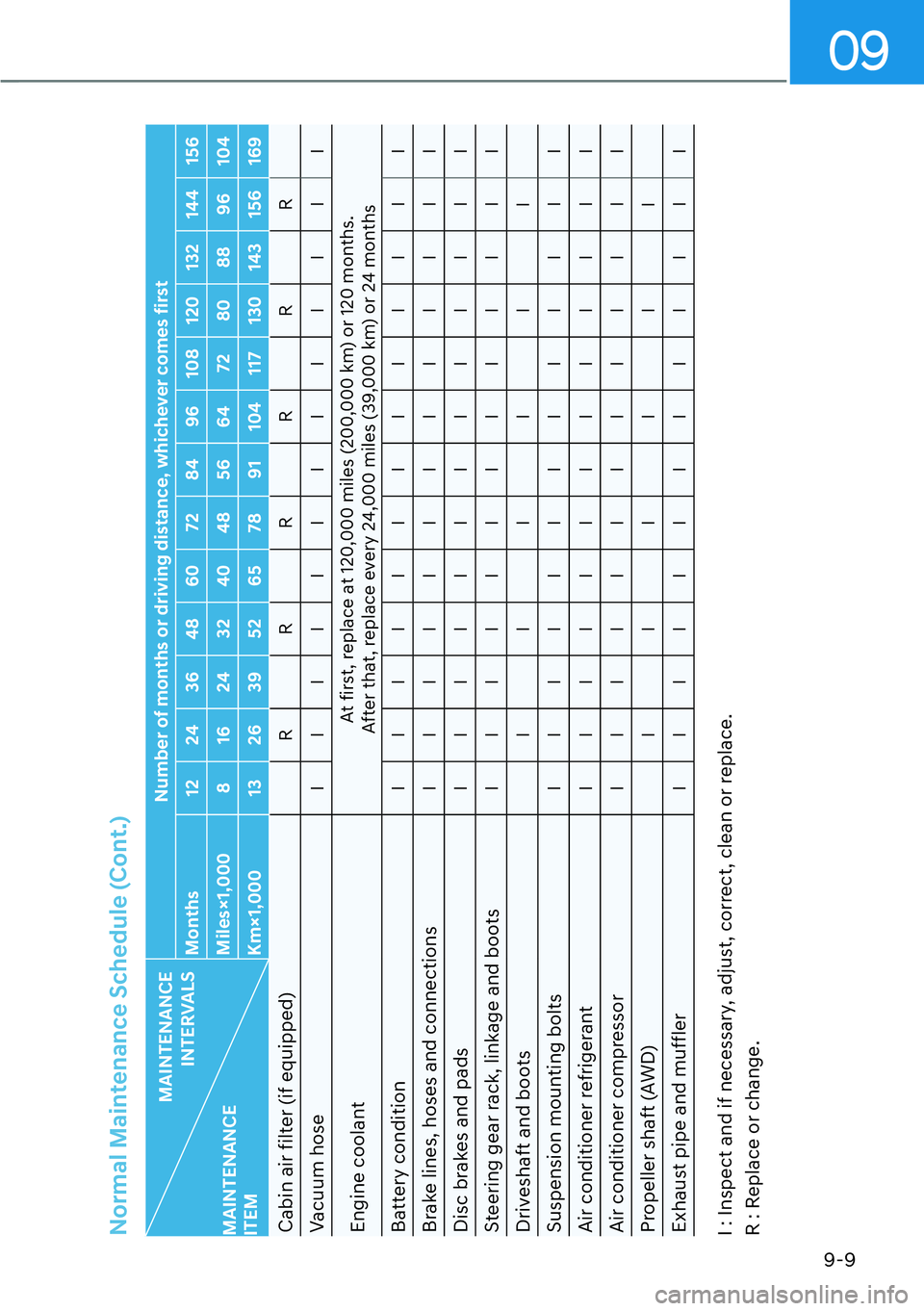
09
9-9
Normal Maintenance Schedule (Cont.)
MAINTENANCE INTERVALS
MAINTENANCE
ITEM Number of months or driving distance, whichever comes first
Months 12 24 36 48 60 72 84 96 108 120 132 144 156
Miles×1,000 8 16 24 32 40 48 56 64 72 80 88 96 104 Km×1,000 13 26 39 52 65 78 91 104 117 130 143 156 169
Cabin air filter (if equipped)
RRRRRR
Vacuum hose
IIIIIIIIIIIII
Engine coolant
At first, replace at 120,000 miles (200,000 km) or 120 months.
After that, replace every 24,000 miles (39,000 km) or 24 months
Battery condition
IIIIIIIIIIIII
Brake lines, hoses and connections
IIIIIIIIIIIII
Disc brakes and pads
IIIIIIIIIIIII
Steering gear rack, linkage and boots
IIIIIIIIIIIII
Driveshaft and boots
IIIIII
Suspension mounting bolts
IIIIIIIIIIIII
Air conditioner refrigerant
IIIIIIIIIIIII
Air conditioner compressor
IIIIIIIIIIIII
Propeller shaft (AWD)
IIIIII
Exhaust pipe and muffler
IIIIIIIIIIIII
I : Inspect and if necessary, adjust, correct, clean or replace.
R : Replace or change.
Page 597 of 661
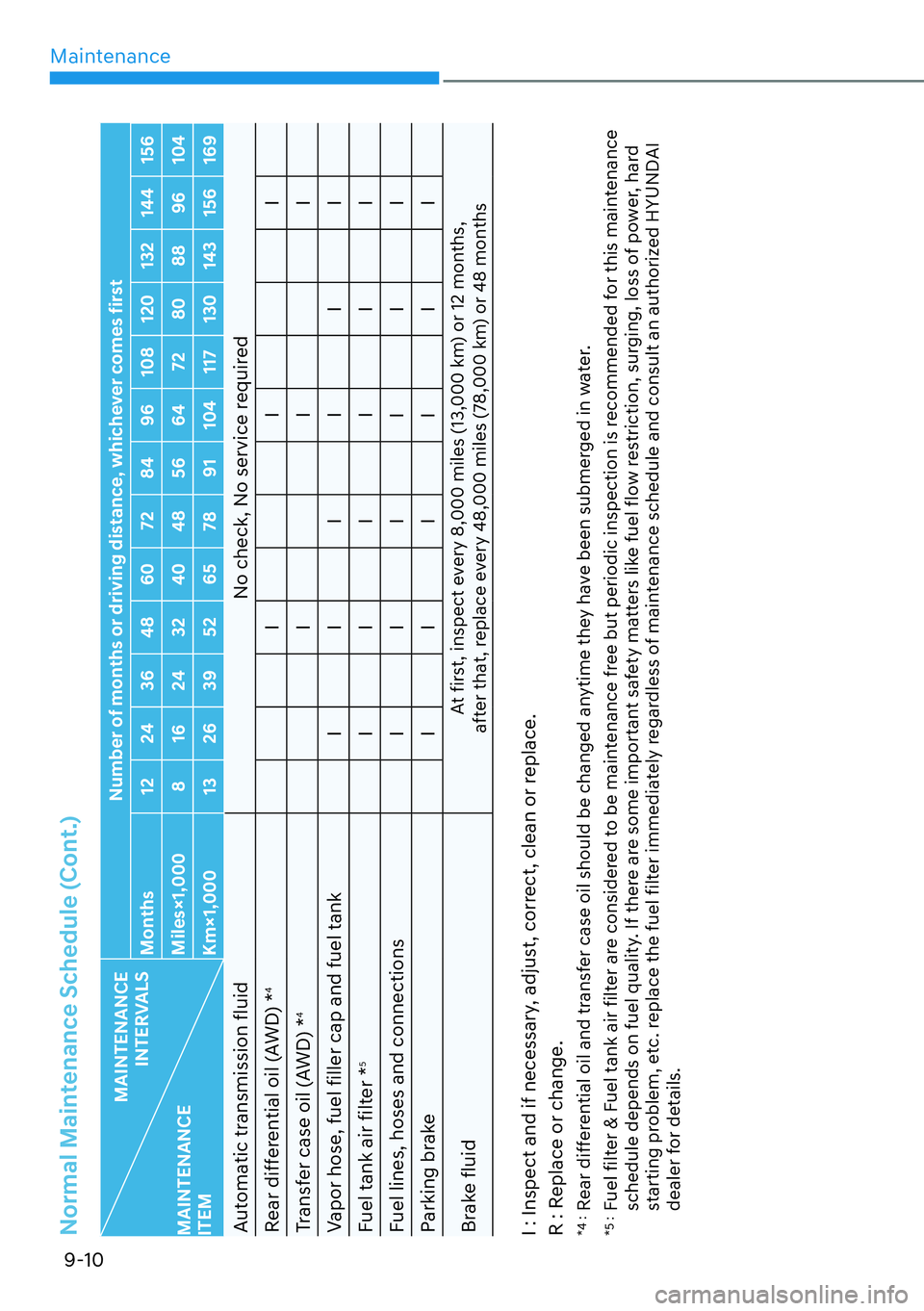
Maintenance9-10
Normal Maintenance Schedule (Cont.)
MAINTENANCE INTERVALS
MAINTENANCE
ITEM Number of months or driving distance, whichever comes first
Months 12 24 36 48 60 72 84 96 108 120 132 144 156
Miles×1,000 8 16 24 32 40 48 56 64 72 80 88 96 104 Km×1,000 13 26 39 52 65 78 91 104 117 130 143 156 169
Automatic transmission fluid No check, No service required
Rear differential oil (AWD) *
4
III
Transfer case oil (AWD) *
4
III
Vapor hose, fuel filler cap and fuel tank IIIIII
Fuel tank air filter *
5
IIIIII
Fuel lines, hoses and connections IIIIII
Parking brake IIIIII
Brake fluidAt first, inspect every 8,000 miles (13,000 km) or 12 months,
after that, replace every 48,000 miles (78,000 km) or 48 months
I : Inspect and if necessary, adjust, correct, clean or replace.
R : Replace or change.*4 :
Rear differential oil and transfer case oil should be changed anytime they have been submerged in water.
*5 :
Fuel filter & Fuel tank air filter are considered to be maintenance free but periodic inspection is recommended for this maintenance
schedule depends on fuel quality. If there are some important safety matters like fuel flow restriction, surging, loss of power, hard
starting problem, etc. replace the fuel filter immediately regardless of maintenance schedule and consult an authorized HYUNDAI
dealer for details.
Page 598 of 661
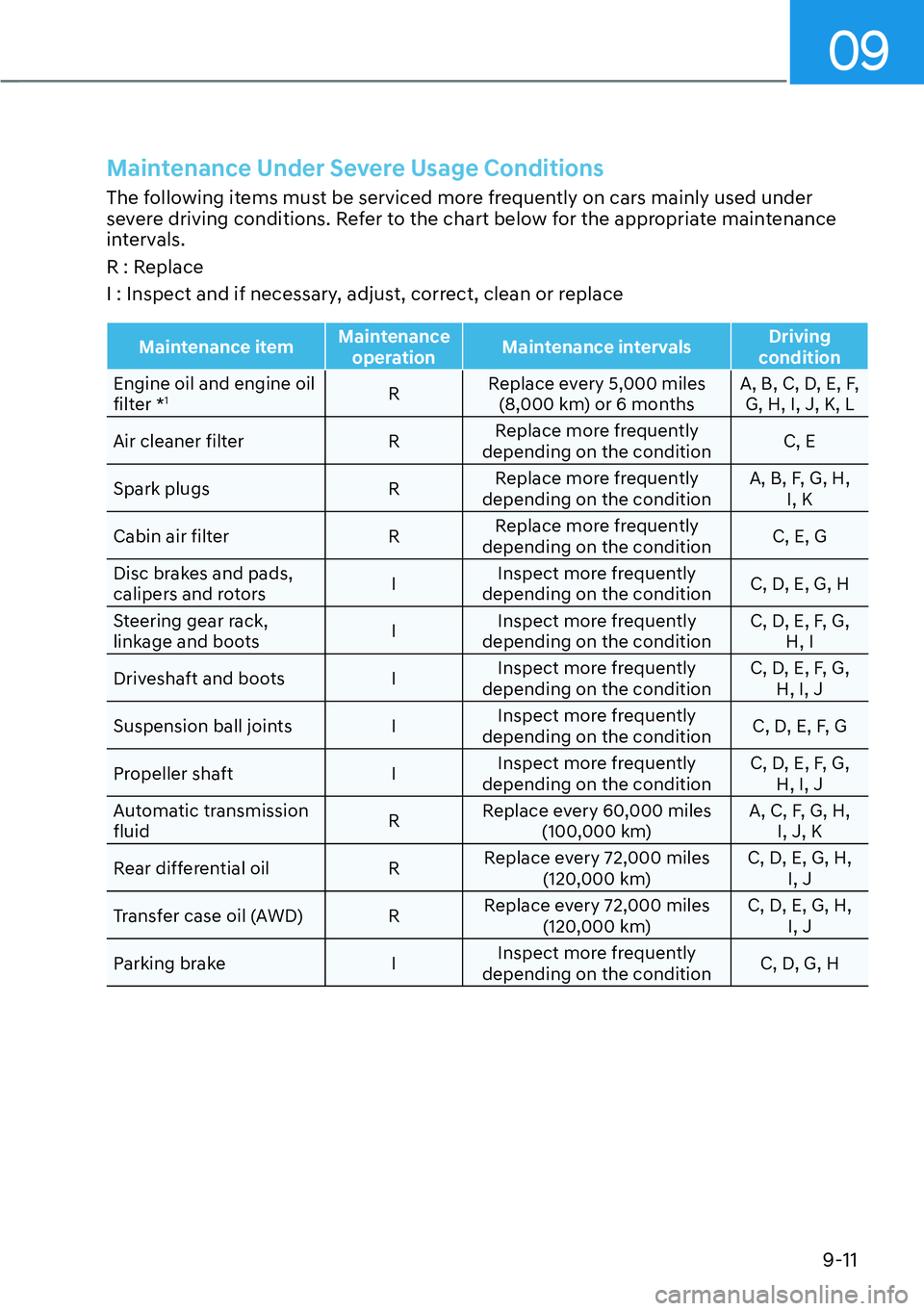
09
9-11
Maintenance Under Severe Usage Conditions
The following items must be serviced more frequently on cars mainly used under
severe driving conditions. Refer to the chart below for the appropriate maintenance
intervals.
R : Replace
I : Inspect and if necessary, adjust, correct, clean or replace
Maintenance itemMaintenance
operation Maintenance intervals Driving
condition
Engine oil and engine oil
filt
er *1R Replace every 5,000 miles
(8,000 km) or 6 months A, B, C, D, E, F,
G, H, I, J, K, L
Air cleaner filter R Replace more frequently
depending on the condition C, E
Spark plugs R Replace more frequently
depending on the condition A, B, F, G, H,
I, K
Cabin air filter R Replace more frequently
depending on the condition C, E, G
Disc brakes and pads,
calipers and rotors IInspect more frequently
depending on the condition C, D, E, G, H
Steering gear rack,
linkage and boots IInspect more frequently
depending on the condition C, D, E, F, G,
H, I
Driveshaft and boots I Inspect more frequently
depending on the condition C, D, E, F, G,
H, I, J
Suspension ball joints I Inspect more frequently
depending on the condition C, D, E, F, G
Propeller shaft I Inspect more frequently
depending on the condition C, D, E, F, G,
H, I, J
Automatic transmission
fluid RReplace every 60,000 miles
(100,000 km) A, C, F, G, H,
I, J, K
Rear differential oil R Replace every 72,000 miles
(120,000 km) C, D, E, G, H,
I, J
Transfer case oil (AWD) R Replace every 72,000 miles
(120,000 km) C, D, E, G, H,
I, J
Parking brake I Inspect more frequently
depending on the condition C, D, G, H
Page 599 of 661
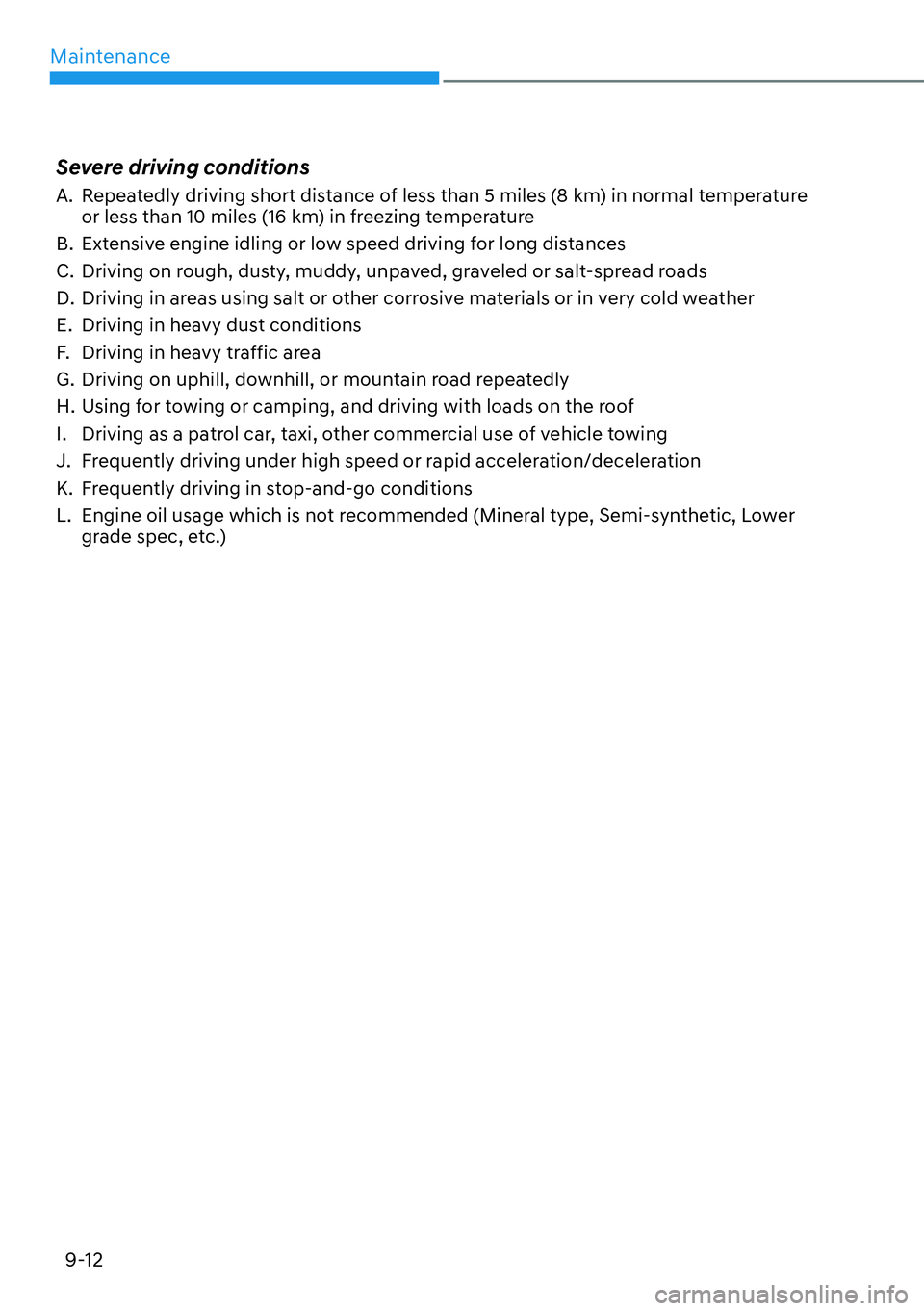
Maintenance9-12
Severe driving conditions
A. Repeatedly driving short distance of less than 5 miles (8 km) in normal temperature or less than 10 miles (16 km) in freezing temperature
B. Extensive engine idling or low speed driving for long distances
C. Driving on rough, dusty, muddy, unpaved, graveled or salt-spread roads
D. Driving in areas using salt or other corrosive materials or in very cold weather
E. Driving in heavy dust conditions
F. Driving in heavy traffic area
G. Driving on uphill, downhill, or mountain road repeatedly
H. Using for towing or camping, and driving with loads on the roof
I. Driving as a patrol car, taxi, other commercial use of vehicle towing
J. Frequently driving under high speed or rapid acceleration/deceleration
K. Frequently driving in stop-and-go conditions
L. Engine oil usage which is not recommended (Mineral type, Semi-synthetic, Lower grade spec, etc.)
Page 600 of 661
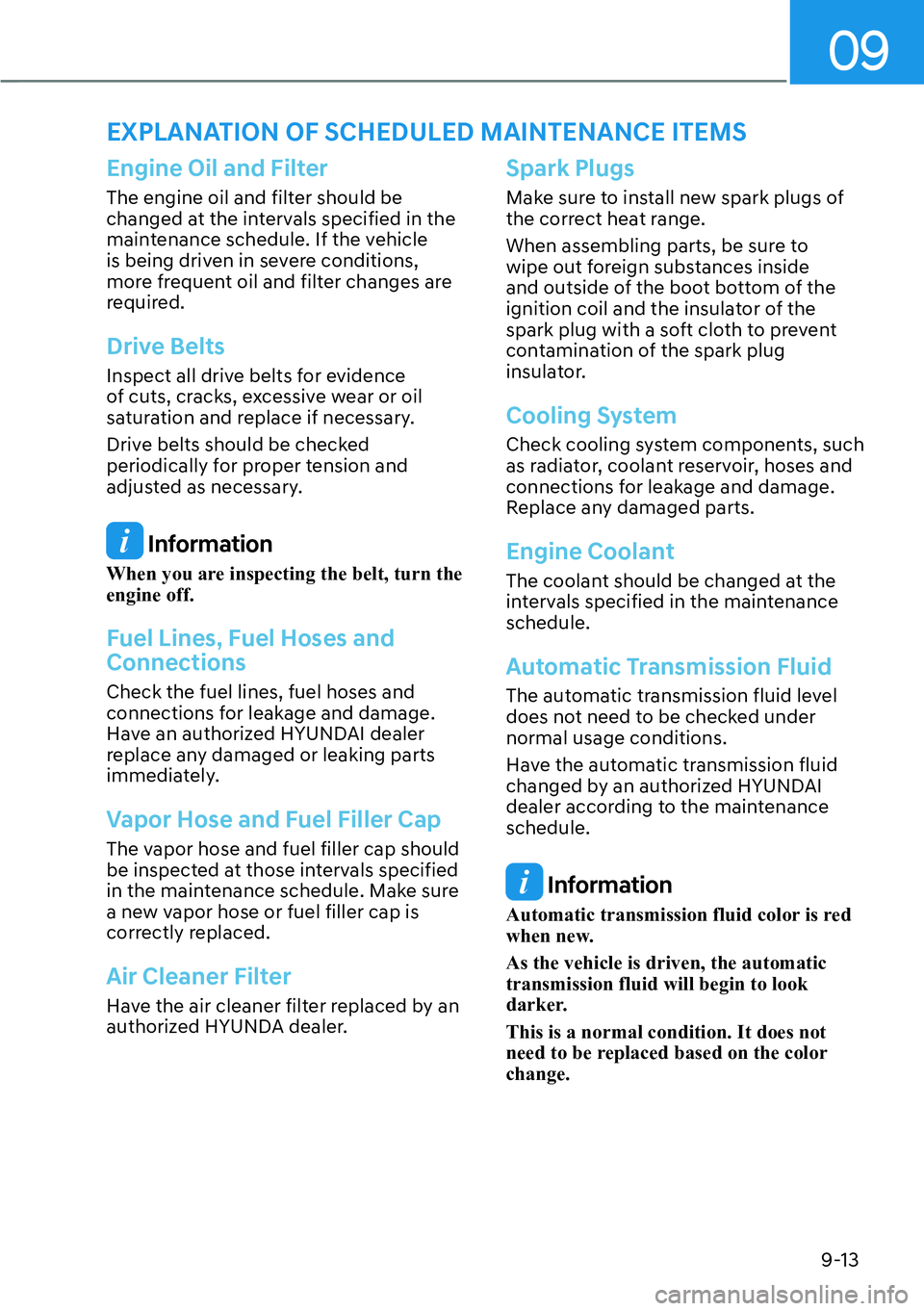
09
9-13
Engine Oil and Filter
The engine oil and filter should be
changed at the intervals specified in the
maintenance schedule. If the vehicle
is being driven in severe conditions,
more frequent oil and filter changes are
required.
Drive Belts
Inspect all drive belts for evidence
of cuts, cracks, excessive wear or oil
saturation and replace if necessary.
Drive belts should be checked
periodically for proper tension and
adjusted as necessary.
Information
When you are inspecting the belt, turn the
engine off.
Fuel Lines, Fuel Hoses and
Connections
Check the fuel lines, fuel hoses and
connections for leakage and damage.
Have an authorized HYUNDAI dealer
replace any damaged or leaking parts
immediately.
Vapor Hose and Fuel Filler Cap
The vapor hose and fuel filler cap should
be inspected at those intervals specified
in the maintenance schedule. Make sure
a new vapor hose or fuel filler cap is
correctly replaced.
Air Cleaner Filter
Have the air cleaner filter replaced by an
authorized HYUNDA dealer.
Spark Plugs
Make sure to install new spark plugs of
the correct heat range.
When assembling parts, be sure to
wipe out foreign substances inside
and outside of the boot bottom of the
ignition coil and the insulator of the
spark plug with a soft cloth to prevent
contamination of the spark plug
insulator.
Cooling System
Check cooling system components, such
as radiator, coolant reservoir, hoses and
connections for leakage and damage.
Replace any damaged parts.
Engine Coolant
The coolant should be changed at the
intervals specified in the maintenance
schedule.
Automatic Transmission Fluid
The automatic transmission fluid level
does not need to be checked under
normal usage conditions.
Have the automatic transmission fluid
changed by an authorized HYUNDAI
dealer according to the maintenance
schedule.
Information
Automatic transmission fluid color is red
when new.
As the vehicle is driven, the automatic
transmission fluid will begin to look
darker.
This is a normal condition. It does not
need to be replaced based on the color
change.
EXPLANATION OF SCHEDULED MAINTENANCE ITEMS
Page 601 of 661
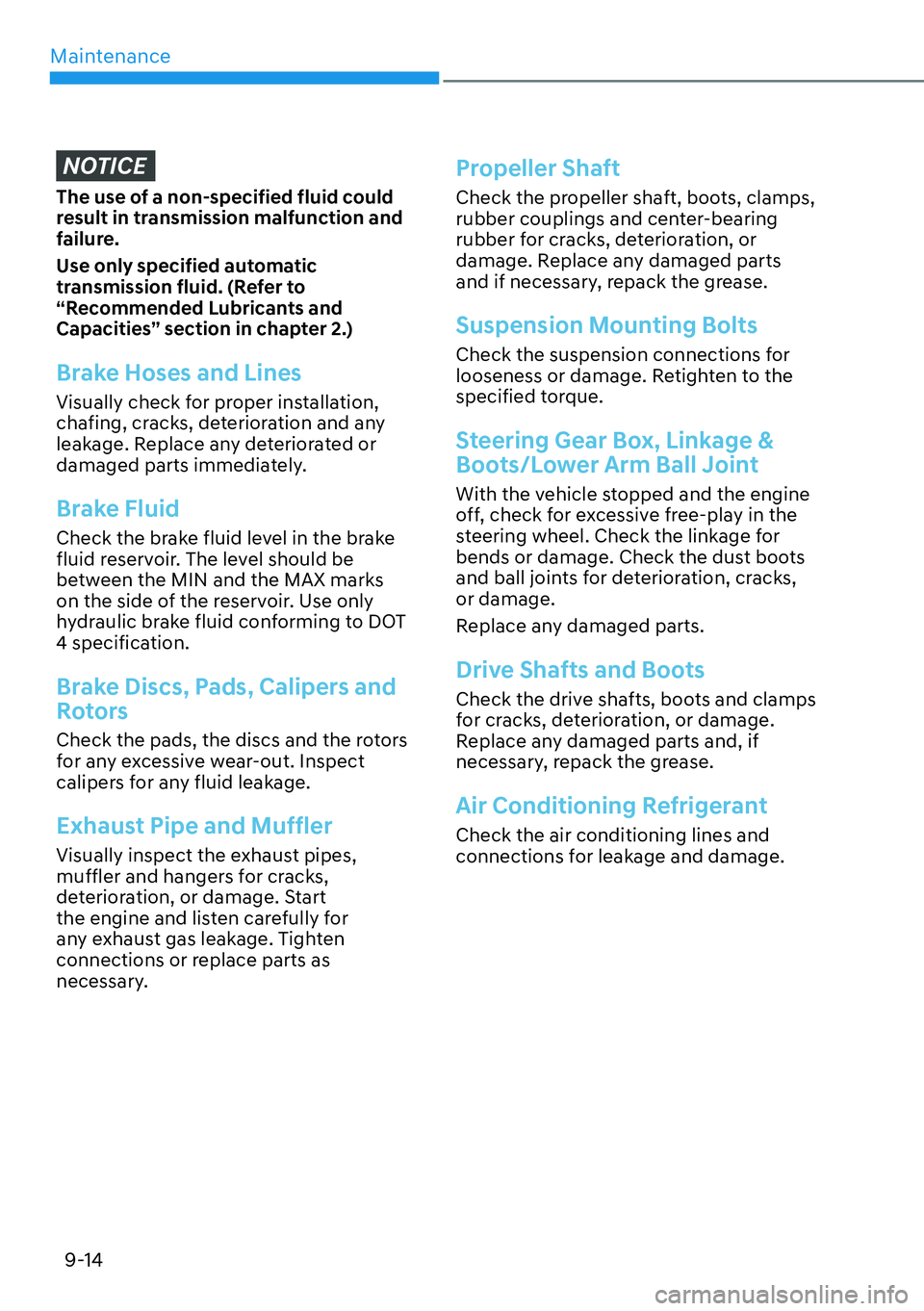
Maintenance9-14
NOTICE
The use of a non-specified fluid could
result in transmission malfunction and
failure.
Use only specified automatic
transmission fluid. (Refer to
“Recommended Lubricants and
Capacities” section in chapter 2.)
Brake Hoses and Lines
Visually check for proper installation,
chafing, cracks, deterioration and any
leakage. Replace any deteriorated or
damaged parts immediately.
Brake Fluid
Check the brake fluid level in the brake
fluid reservoir. The level should be
between the MIN and the MAX marks
on the side of the reservoir. Use only
hydraulic brake fluid conforming to DOT
4 specification.
Brake Discs, Pads, Calipers and
Rotors
Check the pads, the discs and the rotors
for any excessive wear-out. Inspect
calipers for any fluid leakage.
Exhaust Pipe and Muffler
Visually inspect the exhaust pipes,
muffler and hangers for cracks,
deterioration, or damage. Start
the engine and listen carefully for
any exhaust gas leakage. Tighten
connections or replace parts as
necessary.
Propeller Shaft
Check the propeller shaft, boots, clamps,
rubber couplings and center-bearing
rubber for cracks, deterioration, or
damage. Replace any damaged parts
and if necessary, repack the grease.
Suspension Mounting Bolts
Check the suspension connections for
looseness or damage. Retighten to the
specified torque.
Steering Gear Box, Linkage &
Boots/Lower Arm Ball Joint
With the vehicle stopped and the engine
off, check for excessive free-play in the
steering wheel. Check the linkage for
bends or damage. Check the dust boots
and ball joints for deterioration, cracks,
or damage.
Replace any damaged parts.
Drive Shafts and Boots
Check the drive shafts, boots and clamps
for cracks, deterioration, or damage.
Replace any damaged parts and, if
necessary, repack the grease.
Air Conditioning Refrigerant
Check the air conditioning lines and
connections for leakage and damage.
Page 602 of 661
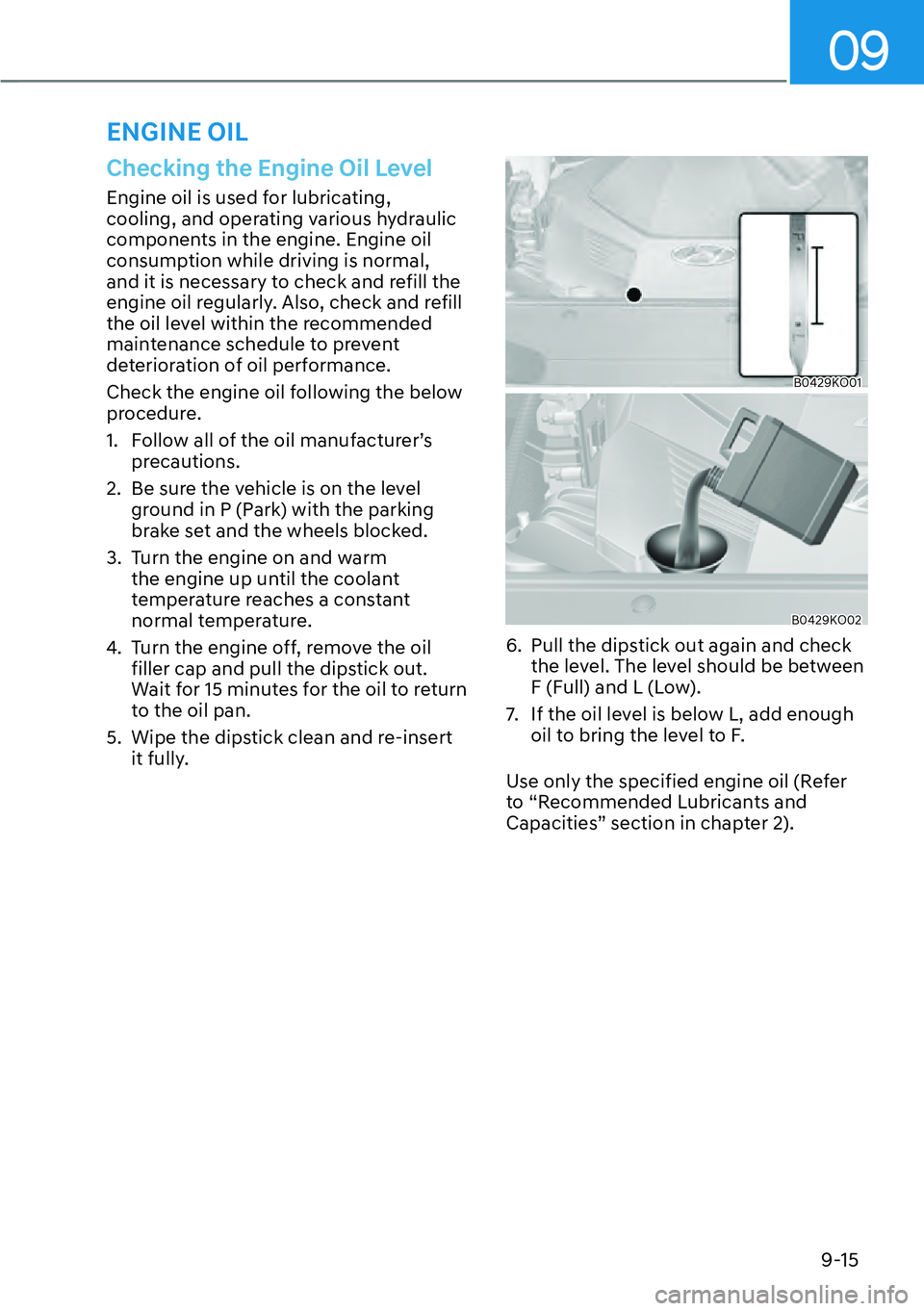
09
9-15
Checking the Engine Oil Level
Engine oil is used for lubricating,
cooling, and operating various hydraulic
components in the engine. Engine oil
consumption while driving is normal,
and it is necessary to check and refill the
engine oil regularly. Also, check and refill
the oil level within the recommended
maintenance schedule to prevent
deterioration of oil performance.
Check the engine oil following the below
procedure.
1. Follow all of the oil manufacturer’s precautions.
2. Be sure the vehicle is on the level ground in P (Park) with the parking
brake set and the wheels blocked.
3. Turn the engine on and warm the engine up until the coolant
temperature reaches a constant
normal temperature.
4. Turn the engine off, remove the oil filler cap and pull the dipstick out.
Wait for 15 minutes for the oil to return
to the oil pan.
5. Wipe the dipstick clean and re-insert it fully.
B0429KO01
B0429KO02
6. Pull the dipstick out again and check the level. The level should be between
F (Full) and L (Low).
7. If the oil level is below L, add enough oil to bring the level to F.
Use only the specified engine oil (Refer
to “Recommended Lubricants and
Capacities” section in chapter 2).
ENGINE OIL